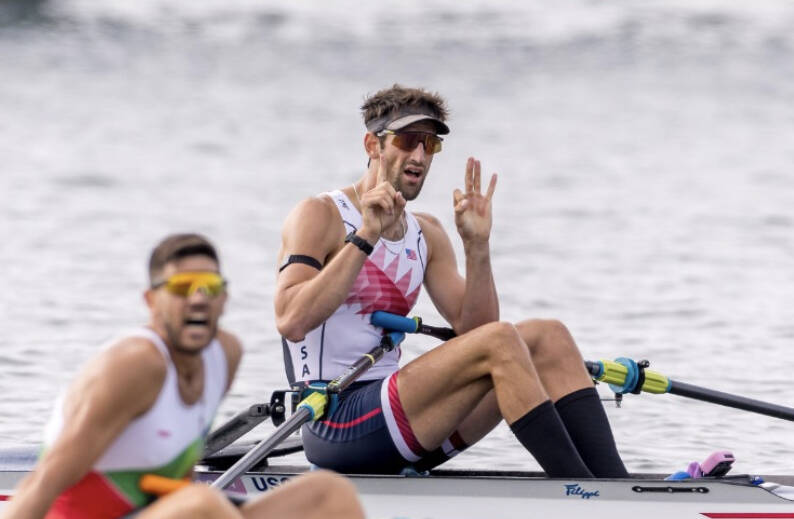When Paris last hosted the Olympic games, it was the year 1924 — one century ago — and rowing was a very different sport.
The boats (and the oars) were made of wood, and the winning race times reflected this difference in boat materials (and weight.)
The winning eight time in 1924 was 6:33 — more than a minute slower than the top times in this year’s Olympic competition.
Of course, there have been a few other developments over those 100 years. No women were allowed to row back then (this year there is gender parity); the United States was the leader in the sport (the world today has caught up, with teams from Great Britain, the Netherlands and New Zealand often out front); and collegiate teams competed for the honor of representing the U.S., whereas now there is intense competition at the individual level to make it into a boat.
And it is through that grueling process that Vashon’s own Jacob Plihal has emerged as the preeminent men’s single sculler for the U.S. In Paris, this summer, he proved that he belongs in the cohort of the rowing world’s elite.
This year’s course was located at Vaires-sur-Marne, about 15 miles from Paris (close when you consider that the surfing venue for this year’s games is in Tahiti — about 10,000 miles away). This town of about 15,000 is best known as the film location for the 1964 World War II film “The Train,” which featured a spectacular special effects scene of the town being blown up.
Newly constructed stands at the venue seated 20,000 people who sat uncovered to experience the weather just like the rowers: rain, humidity or hot direct sun, depending on the day.
The rowing venue featured plenty of fireworks on the water, but thankfully, no explosions. The races follow a standard pattern for international meets: heats, “repechage,” quarterfinals, semifinals and finals. The top three finishers in each heat move on to the quarterfinal directly while the remainder of the rowers in each heat are reshuffled into a repechage round (a “re-row” that attempts to minimize the potential for unfairness in the draws for each heat).
In total, there were 33 rowers organized into six heats of five or six competitors.
Plihal had a strong row in his heat on July 27 (all races occurred in early morning in Pacific time, corresponding to a starting time of roughly 9 a.m. in Paris), coming in second and thus automatically moving on to the quarterfinal.
As a preview to the intense competition that was inescapable in these Olympic men’s singles races, Plihal edged out the third-place boat by merely 0.01 seconds, equivalent to a physical difference at the finish line of two and a half inches, after a race of 2,000 meters. (That’s about the same length as the Kentucky Derby.)
At this point, Plihal had some bad luck: the draw for the quarterfinals found him in a race against the defending Olympic champion and two other incredibly strong European scullers who would go on to finish fourth and seventh in the event.
Plihal rowed the race of his life, setting a personal best by over three seconds, but fell 0.7 seconds shy of the third place finish he needed to stay in medal contention. But no rowers are fully eliminated, so Plihal was off to row again in the C/D semifinal for places 13 through 24.
In the C/D semifinal on August 1, Plihal had another strong row, winning his race and moving onto the C final. In further testimony to the extreme competitiveness of this field, the top five rowers in the two C/D semifinals had times within two seconds of each other. The winner of the other semi-final was the Brazilian rower Verthein Ferreira, who bested Plihal in the final of last fall’s Pan American Games.
Through their multiple international competitions, he and Plihal have developed a personal friendship. But for the C final, friendships get put aside, and it becomes all business.
Whereas all of the earlier races had been rowed in flat conditions with low wind, the finals on August 3 were anything but smooth. “Bumpy” conditions with a seven-knot tailwind buffeted the rowers. Plihal led the C final from start to finish winning by a “whopping” two and a half seconds, setting an American record for the single and besting his friend Verthein by more than five seconds.
This latter result is probably the strongest statement as to how much Plihal has progressed in the last year.
Comparing times between races is fraught, with a number of uncontrolled variables affecting the result. That said, Plihal’s time in the C final would have also won the B final, and would have placed him second in the A final.
Alas, officially, Plihal came in 13th, still a wonderful result — but his final race leaves us to dream a little.
The Vashon Island Rowing Club is planning to host a parade and party for Plihal on August 27 when he returns to the island. The time and venue are to be announced shortly, but please mark your calendar — and plan to come into town to give him an appropriate welcome home.
Pat Call is a masters rower and erstwhile writer on non-traditional sports.


